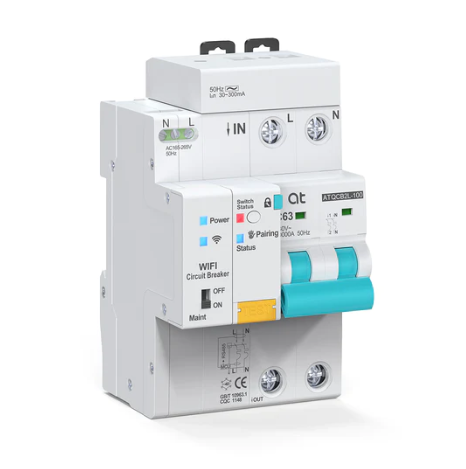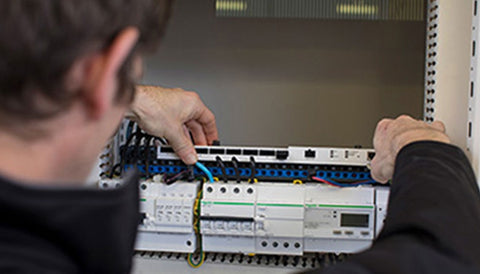A Step-by-Step Guide: How to Change a Smart Circuit Breaker
Inside this Article:
- 1. Understanding Smart Circuit Breakers
- 2. Safety Precautions
- 3. Tools and Materials You'll Need
- 4. Step-by-Step Guide: Replacing a Smart Circuit Breaker Turn Off Power
- Step 1: Turn Off Power
- Step 2: Remove the Old Circuit Breaker
- Step 3: Install the New Smart Circuit Breaker
- Step 4: Connect to the Smart Hub
- Step 5: Restore Power
- Step 6: Test the Smart Circuit Breaker
- 5. Troubleshooting Tips
- 6. Conclusion
In the world of home automation and smart technology, even the most traditional aspects of our homes are getting a high-tech makeover. One such innovation is the smart circuit breaker. These devices not only protect your home's electrical system but also offer remote control and monitoring capabilities. If you're considering upgrading to a smart breaker or need to replace an existing one, this comprehensive guide will walk you through the process step by step.
1. Understanding Smart Circuit Breakers

Before diving into the process of changing a smart circuit breaker, it's essential to understand what these devices are and how they work. Smart breakers are a modern advancement in the field of electrical circuit protection. They are an evolution of traditional circuit breakers, incorporating the latest technological innovations to provide enhanced functionality and convenience. Smart breakers have connectivity, so they can be part of smart home systems and controlled from a distance.
Unlike traditional circuit breakers that simply trip and cut off the electrical supply when an overload or short circuit occurs, smart breakers offer a range of additional features. They have sensors and advanced monitoring abilities to detect and analyze electrical factors like voltage, current, and power usage. This real-time data can be transmitted wirelessly to a central hub or a smartphone app, providing users with valuable insights into their electrical system's performance.
The connectivity aspect of smart breakers opens a world of possibilities for homeowners and building managers. With the ability to remotely control and monitor their electrical system, users can easily manage and optimize their energy consumption. They can control circuits and appliances, set timers for devices, and get alerts for problems or faults.
Furthermore, smart breakers can be integrated with other smart home devices and systems, creating a seamless and interconnected ecosystem. They can communicate with smart meters, allowing users to track their energy usage in real time and make informed decisions to reduce their carbon footprint. They can also be linked with home automation systems, enabling automated responses based on specific triggers or conditions. For example, a smart breaker can automatically shut off power to a circuit if a smoke detector detects a fire, enhancing safety and minimizing potential damage.
In addition to their connectivity and remote control capabilities, smart breakers also offer improved safety features. They can provide more detailed information about the nature and location of a fault, making it easier for electricians to diagnose and resolve issues. Some smart breakers even have built-in self-testing mechanisms that regularly check their functionality and alert users if any problems are detected.
Key features of smart circuit breakers include:
- Remote Control: You can monitor and control your electrical circuits remotely using a smartphone app or a dedicated hub.
- Energy Monitoring: Many smart circuit breakers offer real-time energy consumption data, helping you identify power-hungry devices.
- Notification Alerts: They can send alerts or notifications to your phone in case of power surges or circuit overloads.
- Safety Features: Smart breakers provide enhanced safety with the ability to trip the circuit remotely in case of an emergency.
2. Safety Precautions
Safety should be your top priority when working with electrical systems. Before you start changing a smart circuit breaker, follow these safety precautions:
- Turn off the main electrical supply: Go to your electrical panel and switch off the main circuit breaker to cut power to your entire home.
- Wear appropriate safety gear: Use safety glasses, insulated gloves, and appropriate clothing to protect yourself from potential electrical hazards.
- Ensure proper lighting: Make sure you have sufficient lighting in the electrical panel area to work safely.
- Keep the area dry: Do not perform electrical work in wet or damp conditions.
3. Tools and Materials You'll Need
To change a smart circuit breaker, gather the necessary tools and materials:
- Screwdrivers (flathead and Phillips)
- Pliers
- Voltage tester
- New smart circuit breaker (compatible with your electrical panel)
- Smartphone or tablet with the manufacturer's app
- Hub (if required)
4. Step-by-Step Guide: Replacing a Smart Circuit Breaker Turn Off Power

Now that you're well-prepared, let's go through the process of replacing a smart circuit breaker.
Step 1: Turn Off Power
Ensure the main electrical supply is switched off. Double-check by using a voltage tester on nearby outlets to confirm there's no electricity running through the circuits you'll be working on.
Step 2: Remove the Old Circuit Breaker
Step 3: Install the New Smart Circuit Breaker
Step 4: Connect to the Smart Hub
Step 5: Restore Power
Step 6: Test the Smart Circuit Breaker
5. Troubleshooting Tips

Sometimes, issues may arise during the installation or setup process. Here are some troubleshooting tips:
- Double-check your connections to ensure they are secure.
- Ensure your Wi-Fi signal is strong enough for the smart circuit breaker to connect to the hub.
- Verify that your smartphone or tablet is running the latest version of the app.
- Consult the manufacturer's troubleshooting guide or contact their customer support if you encounter any issues.
6. Conclusion
Changing a smart circuit breaker can enhance your home's electrical safety and provide you with valuable insights into your energy consumption. By following the steps outlined in this guide and adhering to safety precautions, you can successfully replace an old circuit breaker with a smart one and enjoy the benefits of a more connected and efficient electrical system in your home. Remember, if you ever feel unsure about any step in the process, it's best to consult a qualified electrician for assistance to ensure your safety and the proper functioning of your electrical system.
Contact:
AT-ELE
sale@at-ele.com
www.at-ele.com



